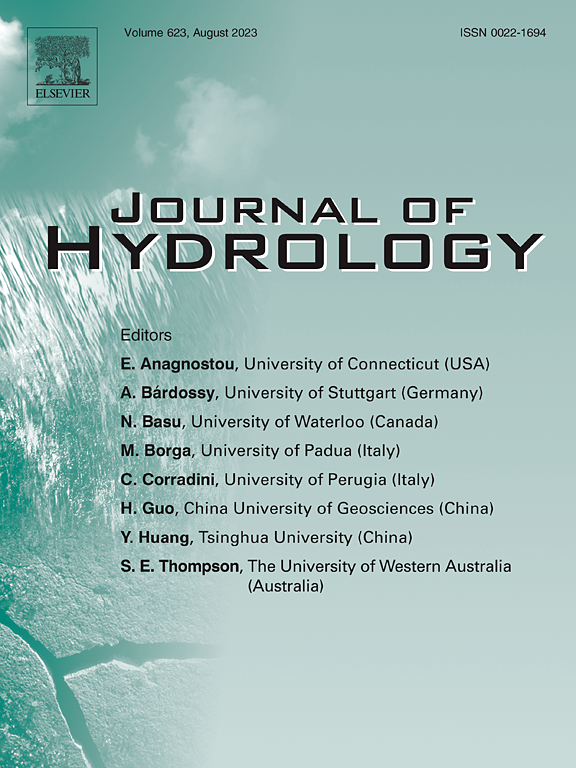Pesticide transport under runoff-erosion potentially dominated by small sediments: A glyphosate and AMPA experiment
IF 5.9
1区 地球科学
Q1 ENGINEERING, CIVIL
引用次数: 0
Abstract
Glyphosate and its degradation product AMPA, are ecotoxic, recurrent and persistent in agricultural soils, susceptible to overland transport by runoff, and sediment erosion due to their strong sorption affinities. We hypothesize that eroded sediments of different sizes have differing sorbed concentrations and relative contributions to glyphosate and AMPA transport, due to different specific surface areas and adsorption site abundances. Hence, we conducted a flume experiment of glyphosate-polluted sediment erosion in a rainfall simulator. After 1 h of rainfall (90 mm water), 10 % of applied glyphosate degraded to AMPA. The top 2 cm of soil retained 68 % of the total glyphosate-equivalent (including AMPA) mass, while runoff and eroded sediment accounted for 8 % and 10 % respectively. Amongst pesticides transported overland, runoff (61 %) and eroded sediment (39 %) were similarly important for glyphosate, but eroded sediment (95 %) transported remarkably more AMPA than runoff (5 %), although glyphosate sorption affinities are typically larger. Small sediments (<0.25 mm) constituted 75 % of eroded sediment counts, but carried 60 % of sediment-phase glyphosate and 85 % of sediment-phase AMPA mass. In < 0.25 mm sediments, unlike glyphosate, AMPA breakthrough concentrations were substantially greater than in larger sediments. As water and pollutant mass exchanges between various environmental compartments (soil moisture, soil grains, runoff, eroded sediment, biodegradation) are highly dynamic, equilibrium sorption affinities alone may not fully characterize the predominant modes of pollutant transport, which may vary across spatio-temporal scales. Therefore, pollutants that are preferentially transported by eroded sediments, particularly small sediments, should be identified and prioritized in future research, due to potentially amplified environmental impacts.
径流侵蚀下的农药运输可能由小沉积物主导:草甘膦和AMPA实验
草甘膦及其降解产物AMPA具有生态毒性,在农业土壤中反复出现并持续存在,由于其强吸附亲和力,易受径流陆路运输和沉积物侵蚀。我们假设由于不同的比表面积和吸附位点丰度,不同大小的侵蚀沉积物具有不同的吸附浓度和对草甘膦和AMPA运输的相对贡献。因此,我们在降雨模拟器上进行了草甘膦污染泥沙侵蚀的水槽实验。在降雨1小时(90毫米水)后,10%的草甘膦降解为AMPA。顶部2 cm土壤保留了68%的草甘膦当量(包括AMPA)质量,而径流和侵蚀泥沙分别占8%和10%。在经陆路运输的农药中,径流(61%)和侵蚀沉积物(39%)对草甘膦同样重要,但侵蚀沉积物(95%)比径流(5%)输送的AMPA明显更多,尽管草甘膦的吸附亲和力通常更大。小沉积物(0.25 mm)占侵蚀沉积物总数的75%,但携带了60%的沉积相草甘膦和85%的沉积相AMPA物质。在& lt;与草甘膦不同,0.25 mm沉积物的AMPA突破浓度明显高于较大沉积物。由于不同环境区隔(土壤水分、土壤颗粒、径流、侵蚀沉积物、生物降解)之间的水和污染物质量交换是高度动态的,仅平衡吸附亲和力可能不能完全表征污染物运输的主要模式,这可能在时空尺度上有所不同。因此,在未来的研究中,由于潜在的放大环境影响,应确定并优先考虑由侵蚀沉积物,特别是小沉积物输送的污染物。
本文章由计算机程序翻译,如有差异,请以英文原文为准。
求助全文
约1分钟内获得全文
求助全文
来源期刊

Journal of Hydrology
地学-地球科学综合
CiteScore
11.00
自引率
12.50%
发文量
1309
审稿时长
7.5 months
期刊介绍:
The Journal of Hydrology publishes original research papers and comprehensive reviews in all the subfields of the hydrological sciences including water based management and policy issues that impact on economics and society. These comprise, but are not limited to the physical, chemical, biogeochemical, stochastic and systems aspects of surface and groundwater hydrology, hydrometeorology and hydrogeology. Relevant topics incorporating the insights and methodologies of disciplines such as climatology, water resource systems, hydraulics, agrohydrology, geomorphology, soil science, instrumentation and remote sensing, civil and environmental engineering are included. Social science perspectives on hydrological problems such as resource and ecological economics, environmental sociology, psychology and behavioural science, management and policy analysis are also invited. Multi-and interdisciplinary analyses of hydrological problems are within scope. The science published in the Journal of Hydrology is relevant to catchment scales rather than exclusively to a local scale or site.
 求助内容:
求助内容: 应助结果提醒方式:
应助结果提醒方式:


